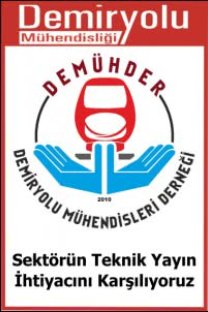Demiryolu Elektrifikasyon Sistemlerinde Topraklama ve Temas Gerilimi
Earthing and Touch Voltage in Railway Electrification Systems
Electrification, Traction Current Earthing, Touch Voltage,
___
[1] TS EN 50119 Railway applications – Fixed installations – Electric traction overhead contact lines[2] D. Serrano-Jiménez, L. Abrahamsson, S. Castaño-Solís, J. Sanz-Feito “Electrical railway power supply systems: Current situation and future trends”, International Journal of Electrical Power & Energy Systems, 92, 181–192. doi:10.1016/j.ijepes.2017.05.008.
[3] TS EN 50163 – Nisan 2013 Demiryolu Uygulamaları – Cer Sistemlerinin Besleme Gerilimleri Railway Applications-Supply voltages of traction systems.
[4] F. Kiessling, R. Puschman, A. Schmieder, Schneider E., “Contact Line for Electric Railways, Planning Design Implementation Maintenance, 2018”.
[5] J. R. Carson, “Wave propagation in overhead wires with ground return,” Bell Syst. Tech. J., vol. 5, pp. 539–554, Oct. 1926.
[6] TS EN 50122 – 1 Demiryolu uygulamaları- Sabit tesisler - Elekriksel güvenlik,topraklama ve dönüş devresi- Bölüm 1:Elektrik çarpmasına karşı koruma önlemleri
[7] A. Mariscotti, P. Pozzobon, “Determination of the electrical parameters of railway traction lines: calculation, measurement, and reference data”, IEEE Transactions On Power Delivery, vol. 19, no. 4, October 2004
- ISSN: 2149-1607
- Yayın Aralığı: 2
- Başlangıç: 2014
- Yayıncı: Demiryolu Mühendisleri Derneği
Yüksek Hızlı Tren Hatlarında Sinyalizasyon Blok mesafelerinin Hesaplanması
Demiryolu Elektrifikasyon Sistemlerinde Topraklama ve Temas Gerilimi
Lojistik Merkezi Kapasite Değerlendirmesi İçin Model Önerisi: Kars Lojistik Merkezi Örneği
Kürşat YILDIZ, Zehra EFE, Mehmet Akif YERLİKAYA
Akıllı Raylı Sistemlerde Kullanılan Alt Sistemlerin Kritik Seviye Analizi
Cevat ÖZARPA, İsa AVCI, Bahadır Furkan KINACI
Cahit GÜRER, Tugce AKILLI TÖRER, Kubilay ASLANTAŞ
Mehmet Sinan YILDIRIM, Ümit GÖKKUŞ, Mustafa KARASAHİN
ETCS Seviye-1 Sisteminde Noktasal Hız Tespitine Dayanan Hemzemin Geçit Tasarımının İncelenmesi
